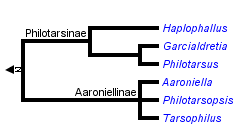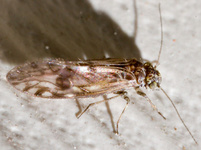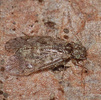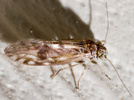Philotarsidae
Emilie Bess and Kevin P. Johnson


This tree diagram shows the relationships between several groups of organisms.
The root of the current tree connects the organisms featured in this tree to their containing group and the rest of the Tree of Life. The basal branching point in the tree represents the ancestor of the other groups in the tree. This ancestor diversified over time into several descendent subgroups, which are represented as internal nodes and terminal taxa to the right.

You can click on the root to travel down the Tree of Life all the way to the root of all Life, and you can click on the names of descendent subgroups to travel up the Tree of Life all the way to individual species.
For more information on ToL tree formatting, please see Interpreting the Tree or Classification. To learn more about phylogenetic trees, please visit our Phylogenetic Biology pages.
close boxIntroduction
The family Philotarsidae contains about 115 species in 6 genera distributed worldwide, with highest diversity in Asia. Eight species are known from North America in the genera Garcialdrete, Philotarsus and Aaroniella.
These are medium-sized bark lice (2-3.5 mm, nymphs 2-3 mm) with robust bodies. Body colors are brown or gray. Philotarsids inhabit bark and rock surfaces; some species live under dense webbing, alone or in small groups.
Philotarsidae contains two subfamilies, Aaronielinae and Philotarsinae, which are designated based on antennal morphology.
Characteristics
Synapomorphy
- Presence of hairs on underside (ventral) surface of forewing.
General Characters
- Head:
- Antennae have 13 segments.
- Compound eyes are less prominent than in some other families,
- Head is often hairy.
- Legs: Tarsi have 3 segments in most species, 2 segments in some Philotarsus.
- Wings:
- Forewing veins with "Caecillius" pattern:
- Areola postica is free of vein M.
- Veins Rs and M are usually fused for part of their length.
- Forewings appear hairy or fuzzy:
- Hairs on margin of forewing form crossing pairs.
- Forewing veins have more than one row of hairs.
- Underside (ventral) surface of forewing is hairy.
- Hindwing
- Hindwing veins Rs, M and Cu are fused at base.
- Hairs on margin are abundant.
- Hairs on veins are few or absent.
- Male:
- Phallosome is closed and rounded apically:
- External parameres are relatively short, only slightly exceeding tip of phallosome.
- Tip of phallosome sometimes has rugose sclerified areas.
- Female:
- Subgenital plate has a single posterior lobe.
- Gonapophyses are complete and well developed:
- Ventral valve is narrow.
- Dorsal valve is rectangular, large and broad.
- External valve is large and hairy.
- Eggs: Eggs are laid singly, encrusted with debris and covered with a few silken threads.
How to Know the Family
- Robust, medium-sized bark lice: 2-3.5 mm.
- Head and thorax often hairy.
- Tarsi have 3 segments in North American species (2 segments in some Philotarsus).
- Adults generally have full-length wings, but occasionally wingless or with short, hairy wings.
- Forewings appear hairy or fuzzy:
- Hairs on margin of forewing form crossing pairs.
- Forewing veins have more than one row of hairs.
- Underside (ventral) surface of forewing is hairy.
- Forewing areola postica is free from vein M.
Family Monophyly
Family monophyly is supported by the unique character of the presence of hair on the underside of the forewing, and by some characters shared with other families: crossing marginal setae of forewing, more than one row of setae on forewing veins, and apically rounded phallosome (Yoshizawa 2002).
Discussion of Phylogenetic Relationships
Relationships within the family Philotarsidae have not been studied in detail.
Position with Psocomorpha
Philotarsidae has traditionally been included in superfamily Homilopsocidea, but molecular data from genus Aaroniella do not support this placement and question the monophyly of superfamily Homilopsocidea (Johnson & Mockford 2003).
References
Johnson, K. P. & E. L. Mockford. 2003. Molecular Systematics of Psocomorpha (Psocoptera). Systematic Entomology 28: 409-40.
Lienhard, C. and C. N Smithers. 2002. Psocoptera (Insecta) World Catalogue and Bibliography. Muséum d'Histoire Naturelle, Geneva, Switzerland.
New, T.R. 2005. Psocids, Psocoptera (Booklice and barklice), 2nd edition: Handbooks for the Identification of British Insects. Vol. 1, Part 7. Royal Entomological Society, London, UK.
Mockford, E. L. 1993. North American Psocoptera (Insecta). Gainesville, Florida: Sandhill Crane Press.
Mockford, E. L. 2007. Species of Philotarsus from north and middle America and a new Philotarsine genus from Mexico, Guatemala, and the Greater Antilles (Psocoptera: Philotarsidae: Philotarsinae). Journal of the New York Entomological Society 114: 108-139.
Smithers, C. N. 1996. Psocoptera. Pp. 1-80, 363-372 (Index) in Wells A. (ed.) Zoological Catalogue of Australia. Vol. 26. Psocoptera, Phthiraptera, Thysanoptera. Melbourne: CSIRO Publishing, Australia.
Yoshizawa, K. 2002. Phylogeny and higher classification of suborder Psocomorpha (Insecta: Psocodea:'Psocoptera'). Zoological Journal of the Linnean Society 136: 371-400.
Smithers, C. N. 1996. Psocoptera. Pp. 1-80, 363-372 (Index) in Wells A. (ed.) Zoological Catalogue of Australia. Vol. 26. Psocoptera, Phthiraptera, Thysanoptera. Melbourne: CSIRO Publishing, Australia.
Yoshizawa, K. 2002. Phylogeny and higher classification of suborder Psocomorpha (Insecta: Psocodea:'Psocoptera'). Zoological Journal of the Linnean Society 136: 371-400.
Yoshizawa, K. and Johnson, K.P. 2008. Molecular systematics of the barklouse family Psocidae (Insecta: Psocidae: 'Psocoptera') and implications for morphological and behavioral evolution. Molecular Phylogenetics and Evolution 46: 547-559.
Title Illustrations

| Scientific Name | Aaroniella |
|---|---|
| Location | Belchertown, Massachusetts, USA |
| Specimen Condition | Live Specimen |
| Identified By | Ed Mockford |
| Size | ~2 mm |
| Source | Photo#216531 |
| Source Collection | BugGuide.Net |
| Image Use |
 This media file is licensed under the Creative Commons Attribution-NonCommercial-NoDerivs License - Version 1.0. This media file is licensed under the Creative Commons Attribution-NonCommercial-NoDerivs License - Version 1.0.
|
| Copyright | © Charley Eiseman |
| Scientific Name | Philotarsus picicornis |
|---|---|
| Location | Logy Bay, N47º37.830' W052º41.258' (WGS84), Northeast Avalon, Newfoundland/Labrador, Canada |
| Specimen Condition | Live Specimen |
| Identified By | Philip Careless |
| Size | 4mm Head to wing tips |
| Source | Photo#72444 |
| Source Collection | BugGuide.Net |
| Image Use |
 This media file is licensed under the Creative Commons Attribution-NonCommercial-NoDerivs License - Version 1.0. This media file is licensed under the Creative Commons Attribution-NonCommercial-NoDerivs License - Version 1.0.
|
| Copyright | © Mardon Erbland |
About This Page
Emilie Bess

Illinois Natural History Survey, Champaign, Illinois, USA
Kevin P. Johnson

Illinois Natural History Survey, Champaign, Illinois, USA
Correspondence regarding this page should be directed to Emilie Bess at and Kevin P. Johnson at
Page copyright © 2009 Emilie Bess and Kevin P. Johnson
All Rights Reserved.
- First online 25 March 2009
- Content changed 25 March 2009
Citing this page:
Bess, Emilie and Kevin P. Johnson. 2009. Philotarsidae. Version 25 March 2009 (under construction). http://tolweb.org/Philotarsidae/30251/2009.03.25 in The Tree of Life Web Project, http://tolweb.org/









 Go to quick links
Go to quick search
Go to navigation for this section of the ToL site
Go to detailed links for the ToL site
Go to quick links
Go to quick search
Go to navigation for this section of the ToL site
Go to detailed links for the ToL site